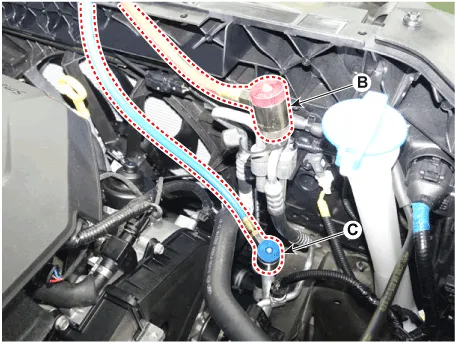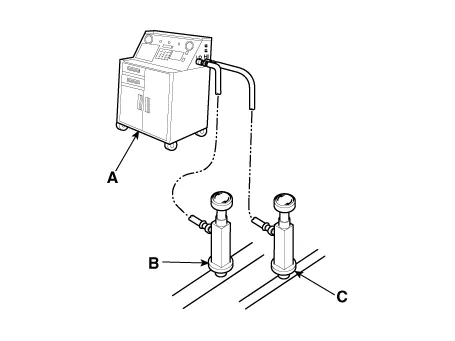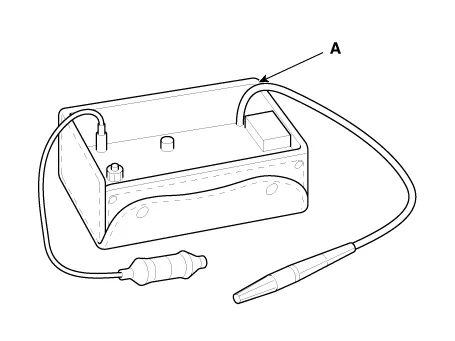Hyundai Santa Fe (TM): Air conditioning System / Repair procedures
| Refrigerant System Service Basics (R-134a) |
Refrigerant Recovery
Use only service equipment that is U.L-listed and is certified to meet the requirements
of SAE J2210 to remove HFC-134a(R-134a) from the air conditioning system.
|
If accidental system discharge occurs, ventilate the work area before resume
of service.
Additional health and safety information may be obtained from the refrigerant
and lubricant manufacturers.
| 1. |
Connect an R-134a refrigerant Recovery / Recycling / Charging System
(A) to the high-pressure service port (B) and the low-pressure service
port (C) as shown, following the equipment
|
| 2. |
Measure the amount of refrigerant oil removed from the A/C system after
the recovery process is completed. Be sure to install the same amount
of new refrigerant oil back into the A/C system before charging.
|
System Evacuation
Use only service equipment that is U.L-listed and is certified to meet the requirements
of SAE J2210 to remove HFC-134a(R-134a) from the air conditioning system.
|
If accidental system discharge occurs, ventilate the work area before resume
of service.
Additional health and safety information may be obtained from the refrigerant
and lubricant manufacturers.
| 1. |
When an A/C system has been opened to the atmosphere, such as during
installation or repair, it must be evacuated using a R-134a refrigerant
Recovery/Recycling/Charging system. (If the system has been open for
several days, the receiver/drier should be replaced, and the system
should be evacuated for several hours.)
|
| 2. |
Connect a R-134a refrigerant Recovery/Recycling/Charging system (A)
to the high-pressure service port (B) and the low-pressure service port
(C) as shown, following the equipment manufacturer's instructions.
|
| 3. |
If the low-pressure does not reach more than 93.3 kPa (700 mmHg, 27.6
in.Hg) in 10 minutes, there is probably a leak in the system. Partially
charge the system, and check for leaks (see Refrigerant Leak Test.)
|
| 4. |
Remove the low pressure valve from the low-pressure service port.
|
System Charging
Use only service equipment that is U.L-listed and is certified to meet the requirements
of SAE J2210 to remove HFC-134a(R-134a) from the air conditioning system.
|
If accidental system discharge occurs, ventilate the work area before resume
of service.
Additional health and safety information may be obtained from the refrigerant
and lubricant manufacturers.
| 1. |
Connect a R-134a refrigerant
Recovery/Recycling/Charging system (A) to the high-pressure service
port (B) as shown, following the equipment manufacturer's instructions.
|
| 2. |
Add the same amount of new refrigerant oil to the system that was removed
during recovery. Use only specified refrigerant oil. Charge the system
with [Single front only : 650 ± 25g (20.9 ± 0.88oz) , Dual front & rear
: 850 ± 25g (29.9 ± 0.88oz)] R-134a refrigerant. Do not overcharge the
system the compressor will be damaged.
|
Refrigerant Leak Test
Always conduct a leak test with an electronic leak detector whenever leakage
or refrigerant is suspected and when conducting service operations which are
accompanied by disassembly or loosening or connection fittings.
In order to use the leak detector properly, read the manual supplied
by the manufacturer.
|
If a gas leak is detected, proceed as follows:
| 1. |
Check the torque on the connection fittings and, if too loose, tighten
to the proper torque. Check for gas leakage with a leak detector (A).
|
| 2. |
If leakage continues even after the fitting has been tightened, discharge
the refrigerant from the system, disconnect the fittings, and check
their seating faces for damage. Always replace, even if the damage is
slight.
|
| 3. |
Check the compressor oil and add oil if required.
|
| 4. |
Charge the system and recheck for gas leaks. If no leaks are found,
evacuate and charge the system again.
|
| Refrigerant System Service Basics (R-1234yf) |
Refrigerant Identification
| • |
Do not mix HFO-1234yf (R-1234yf) in the vehicle with other refrigerant,
such as R-12, R-134a and etc.
|
| • |
Use only service equipment that is U.L-listed and is certified to meet
the requirements of SAE standards to recover and recycle R-1234yf from
the air conditioning system. Do not use service equipment for the other
refrigerant, such as R-12, R-134a and etc.
|
| • |
Verify what refrigerant is in the system if there is concern that the
system has been tampered with in any way and check the type and quantity
of refrigerant that shall be in the A/C system and potential issues
arising from accidental or intentional mixing of refrigerants.
|
| • |
Using an SAE certified refrigerant identification device is recommended
to prevent improper recovery and the resulting further spread of contaminated
refrigerant, which could potentially damage other A/C systems and service
equipment. Contaminated refrigerant (blend of more than one refrigerant
or non-system refrigerant) in recovery/recycling equipment could lead
to the potential contamination of more refrigerant.
|
| • |
Certain types of electronic leak detection devices (heated diode or
corona discharge) as well as motors, switches, and controls on recovery
and recycling machines, could generate sparks that could serve as ignition
sources in the presence of refrigerants classified as flammable (A2
or A3) by ASHRAE standard 34 2006.
|
| • |
It is possible that the mixing of refrigerants in a A/C system can result
in higher-than-expected system pressures, system and component damage,
diagnostic errors and/or other potential hazards to people and environment.
|
| • |
In case other refrigerant is mixed, recover the contaminated refrigerant
in the A/C system and dispose it in accordance with all applicable national,
regional or local regulations. Clean inside the A/C system using the
specialized detergent and recharge new refrigerant.
|
Refrigerant Recovery
Use only service equipment that is U.L-listed and is certified to meet the requirements
of SAE standards to remove HFO-1234yf (R-1234yf) from the air conditioning system.
|
If accidental system discharge occurs, ventilate work area before resume of
service.
Additional health and safety information may be obtained from the refrigerant
and lubricant manufacturers.
| 1. |
Connect an R-1234yf refrigerant Recovery / Recycling / Charging System
(A) to the high-pressure service port (B) and the low-pressure service
port (C) as shown, following the equipment
|
| 2. |
Measure the amount of refrigerant oil removed from the A/C system after
the recovery process is completed. Be sure to install the same amount
of new refrigerant oil back into the A/C system before charging.
|
System Evacuation
Use only service equipment that is U.L-listed and is certified to meet the requirements
of SAE standards to remove HFO-1234yf (R-1234yf) from the air conditioning system.
|
If accidental system discharge occurs, ventilate work area before resume of
service.
Additional health and safety information may be obtained from the refrigerant
and lubricant manufacturers.
| 1. |
When an A/C System has been opened to the atmosphere, such as during
installation or repair, it must be evacuated using an R-1234yf refrigerant
Recovery/Recycling/Charging System. (If the system has been open for
several days, the receiver/dryer should be replaced, and the system
should be evacuated for several hours.)
|
| 2. |
Connect an R-1234yf refrigerant
Recovery/Recycling/Charging System (A) to the high-pressure service
port (B) and the low-pressure service port (C) as shown, following the
equipment manufacturer's instructions.
|
| 3. |
If the low-pressure does not reach more than 87.7 kPa (658 mmHg, 25.9
in.Hg) in 5 minutes, there is probably a leak in the system. Partially
charge the system, and check for leaks (see "Refrigerant Leak Test").
|
| 4. |
Remove the low pressure valve from the low-pressure service port.
|
System Charging
Use only service equipment that is U.L-listed and is certified to meet the requirements
of SAE standards to remove HFO-1234yf (R-1234yf) from the air conditioning system.
|
If accidental system discharge occurs, ventilate work area before resume of
service.
Additional health and safety information may be obtained from the refrigerant
and lubricant manufacturers.
| 1. |
Connect an R-1234yf refrigerant
Recovery/Recycling/Charging System (A) to the high-pressure service
port (B) as shown, following the equipment manufacturer's instructions.
|
| 2. |
Add the same amount of new refrigerant oil to the system that was removed
during recovery. Use only specified refrigerant oil. Charge the system
with [Single front only : 625±25g (22.0±0.88oz) , Dual front & rear
: 800±25g (28.2±0.88oz)] R-1234yf refrigerant. Do not overcharge the
system the compressor will be damaged.
|
Refrigerant Leak Test
Always conduct a leak test with an electronic leak detector whenever leakage
or refrigerant is suspected and when conducting service operations which are
accompanied by disassembly or loosening or connection fittings.
|
|
If a gas leak is detected, proceed as follows :
| 1. |
Check the torque on the connection fittings and, if too loose, tighten
to the proper torque. Check for gas leakage with a leak detector (A).
|
| 2. |
If leakage continues even after the fitting has been tightened, discharge
the refrigerant from the system, disconnect the fittings, and check
their seating faces for damage. Always replace, even if the damage is
slight.
|
| 3. |
Check the compressor oil and add oil if required.
|
| 4. |
Charge the system and recheck for gas leaks. If no leaks are found,
evacuate and charge the system again.
|
Component Location Index Engine Room 1. Service port (High pressure) 2. A/C pressure transducer (APT) 3. Service port (Low pressure) 4.
Oil Specification 1. The R-134a or R-1234yf system requires synthetic (PAG) compressor oil whereas the R-12 system requires mineral compressor oil.
Other information:
Hyundai Santa Fe (TM) 2019-2023 Service and Repair Manual: Refrigerant Line. Components and components location
Hyundai Santa Fe (TM) 2019-2023 Service and Repair Manual: Driver Parking Assistance System
Desctiprion and operation Description ADAS_PRK is a unit that controls the functions required for ADAS parking. If the ADAS_PRK is applied, the parking distance warning function is also controlled by the ADAS_PRK. System Function Parking Collision-Avoidance Assist (PCA) PCA is a parking safety system
Categories
- Manuals Home
- Hyundai Santa Fe Owners Manual
- Hyundai Santa Fe Service Manual
- Heating,Ventilation And Air Conditioning
- Automatic Transaxle System (SBC)
- Front Radar Unit. Repair procedures
- New on site
- Most important about car
Copyright © 2025 www.hsafe4.com - 0.0232





